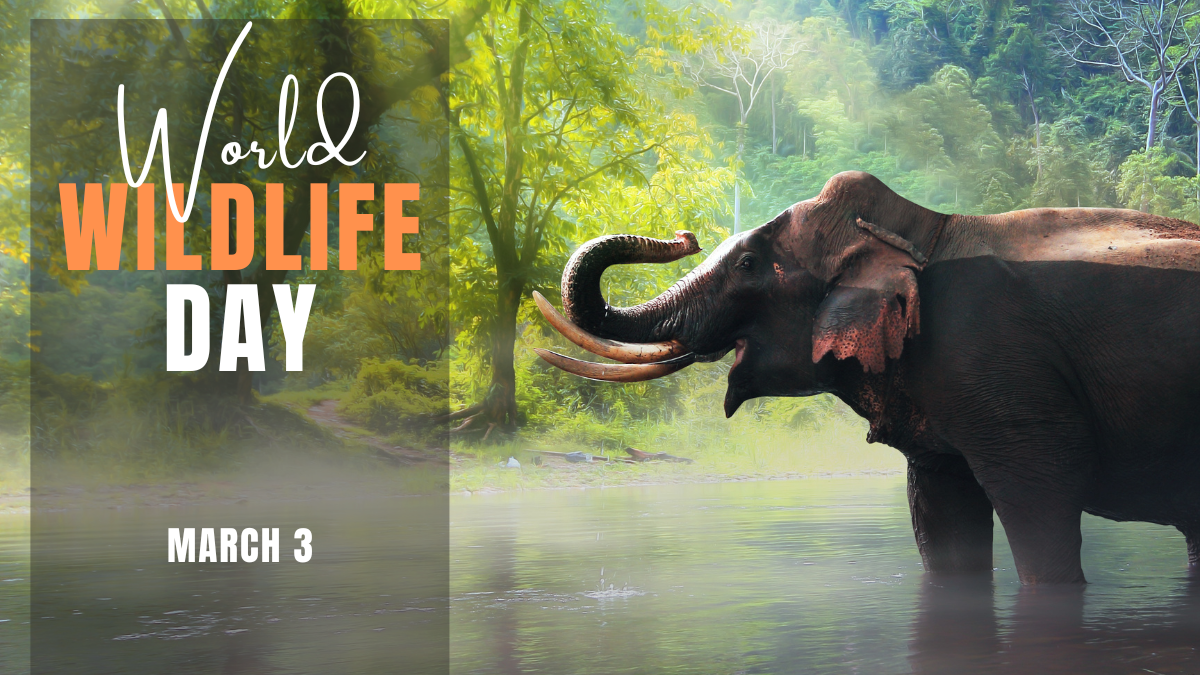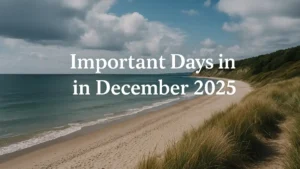World Wildlife Day is a global event observed annually to celebrate and raise awareness about the world’s wild animals and plants. In the face of an escalating triple planetary crisis, climate change, biodiversity loss, and environmental pollution, over one million species are at risk of extinction. This day serves as a crucial reminder of the urgent need for conservation efforts and sustainable practices to protect endangered species and their habitats.
World Wildlife Day provides an opportunity for individuals, communities, organizations, and governments to unite in promoting policies that support wildlife conservation. It is a day of education, advocacy, and action, encouraging people to take meaningful steps toward a sustainable and wildlife-friendly future.
World Wildlife Day 2025: Date and Theme
World Wildlife Day is observed every year on March 3 to commemorate the adoption of the Convention on International Trade in Endangered Species of Wild Fauna and Flora (CITES) in 1973. In 2025, the day falls on Monday, March 3, and will be celebrated under the theme:
“Wildlife Conservation Finance: Investing in People and Planet”
This theme underscores the importance of financial investments in conservation efforts, emphasizing that a sustainable future depends on securing and utilizing financial resources effectively. It highlights the need for collaboration between governments, private institutions, and global organizations to enhance the effectiveness of conservation funding.
By focusing on financial sustainability, World Wildlife Day 2025 aims to promote strategies that ensure long-term conservation efforts, benefiting both human communities and the environment. The theme also encourages corporate responsibility, community-driven conservation initiatives, and policy-level changes to strengthen wildlife protection.
The Origin and Significance of World Wildlife Day
How Did World Wildlife Day Begin?
World Wildlife Day was officially established by the United Nations General Assembly (UNGA) in December 2013. The proposal was initiated by Thailand, urging global attention toward the urgent need for wildlife protection. March 3 was chosen as the date because it marks the adoption of CITES, a critical international agreement dedicated to protecting endangered species from overexploitation due to international trade.
Why is World Wildlife Day Important?
World Wildlife Day plays a crucial role in advocating for biodiversity conservation and promoting actions to address the challenges faced by wildlife. Its significance can be understood in several ways:
- Raising Global Awareness: The day serves as a platform for discussions on the importance of wildlife and ecosystems.
- Encouraging Conservation Policies: It urges governments and organizations to strengthen environmental laws and regulations.
- Highlighting Biodiversity Loss: With human activities, climate change, and habitat destruction threatening numerous species, this day stresses the importance of immediate action.
- Engaging People in Conservation Efforts: From students to policymakers, the event brings people together to support wildlife protection initiatives.
The Role of CITES in Wildlife Conservation
The Convention on International Trade in Endangered Species of Wild Fauna and Flora (CITES) is an international treaty that regulates the global trade of wildlife and wildlife products. Signed by 184 countries, CITES works to ensure that trade in wildlife species does not threaten their survival.
The treaty provides protection for over 38,000 species, including mammals, birds, reptiles, amphibians, fish, and plants. By monitoring, regulating, and restricting trade, CITES helps prevent the illegal wildlife trade, which remains a significant threat to biodiversity.
World Wildlife Day 2025: Key Activities and Global Participation
1. Educational Events and Workshops
Various schools, universities, and conservation organizations will host seminars, lectures, and interactive sessions to educate people about the importance of biodiversity and conservation financing. These events aim to create awareness about financial strategies and investments that support wildlife conservation.
2. Advocacy Campaigns and Social Media Movements
Global campaigns will be launched to spread awareness about the importance of conservation funding. Hashtags like #WorldWildlifeDay2025, #InvestInNature, and #FinanceForWildlife will be used across social media platforms to encourage discussions and drive action.
3. Policy Dialogues and Government Initiatives
Governments and international organizations will engage in discussions to strengthen wildlife protection laws, increase funding for conservation projects, and promote financial models that support sustainable development. These dialogues will also address corporate responsibility in conservation finance.
4. Community-Based Conservation Projects
Local communities play a crucial role in protecting biodiversity. Indigenous and rural communities will participate in initiatives focused on restoring habitats, preventing poaching, and promoting sustainable livelihoods that align with conservation goals.
5. Fundraising and Wildlife Sponsorship Programs
Many environmental NGOs and wildlife conservation organizations will run fundraising campaigns to support endangered species. People will be encouraged to donate, adopt an animal, or contribute to habitat restoration programs.
The Role of Finance in Wildlife Conservation
Why is Financial Investment Essential for Conservation?
Conservation projects require substantial financial support to be effective. Funding is essential for:
- Wildlife Protection Programs – Strengthening anti-poaching efforts, improving law enforcement, and protecting endangered species.
- Habitat Restoration and Conservation – Ensuring that ecosystems are preserved and restored for the survival of various species.
- Research and Monitoring – Conducting scientific studies to track population trends, understand threats, and develop conservation strategies.
- Community-Based Conservation – Involving local communities in conservation initiatives by providing them with sustainable livelihood options.
- Educational and Awareness Campaigns – Teaching future generations the importance of biodiversity and its conservation.
Innovative Financing Solutions for Wildlife Protection
To make conservation efforts more sustainable, organizations are adopting new financial strategies, including:
- Public-Private Partnerships (PPP): Encouraging collaboration between governments, corporations, and conservation organizations.
- Green Bonds and Conservation Funds: Allocating financial resources specifically for wildlife protection and habitat conservation.
- Eco-Tourism Revenue: Using tourism earnings to fund conservation projects while promoting responsible travel.
- Corporate Social Responsibility (CSR) Initiatives: Encouraging businesses to support conservation programs as part of their CSR commitments.
Summary of the World Wildlife Day 2025
| Topic | Details |
|---|---|
| Why in News? | World Wildlife Day 2025 will be observed on March 3, 2025, with the theme “Wildlife Conservation Finance: Investing in People and Planet.” The theme highlights the importance of financial investments in wildlife conservation. |
| Date of Observation | March 3 (every year, marking the adoption of CITES in 1973). In 2025, it falls on Monday, March 3. |
| Theme for 2025 | “Wildlife Conservation Finance: Investing in People and Planet” – emphasizes financial sustainability in conservation efforts. |
| Significance | – Raises awareness about wildlife protection. – Encourages conservation policies and financial investments. – Highlights biodiversity loss and climate-related threats. – Promotes sustainable solutions for conservation funding. |
| Origin of World Wildlife Day | – Established by the United Nations General Assembly (UNGA) in 2013 after Thailand’s proposal. – March 3 marks the adoption of the Convention on International Trade in Endangered Species of Wild Fauna and Flora (CITES) in 1973. |
| Role of CITES | – Regulates global trade of wildlife and wildlife products. – Protects over 38,000 species from overexploitation. – Signed by 184 countries to ensure sustainable trade of wildlife. |
| Key Activities in 2025 | – Educational Events & Workshops: Raising awareness about conservation financing. – Advocacy Campaigns & Social Media Movements: Spreading awareness using hashtags like #WorldWildlifeDay2025. – Policy Dialogues & Government Initiatives: Strengthening wildlife protection laws and financial models. – Community-Based Conservation Projects: Encouraging local involvement in conservation. – Fundraising & Sponsorship Programs: Supporting endangered species through donations. |
| Why is Conservation Finance Important? | – Supports wildlife protection programs like anti-poaching efforts. – Helps in habitat restoration and conservation. – Funds scientific research and population monitoring. – Encourages community-based conservation efforts. |
| Innovative Financial Solutions | – Public-Private Partnerships (PPP): Collaboration between governments and corporations. – Green Bonds & Conservation Funds: Allocating resources specifically for wildlife protection. – Eco-Tourism Revenue: Using tourism earnings to fund conservation. – Corporate Social Responsibility (CSR) Initiatives: Encouraging businesses to support conservation programs. |



 International Human Solidarity Day 2025:...
International Human Solidarity Day 2025:...
 Goa Liberation Day 2025: History, Signif...
Goa Liberation Day 2025: History, Signif...
 Important Days in December 2025, Nationa...
Important Days in December 2025, Nationa...







